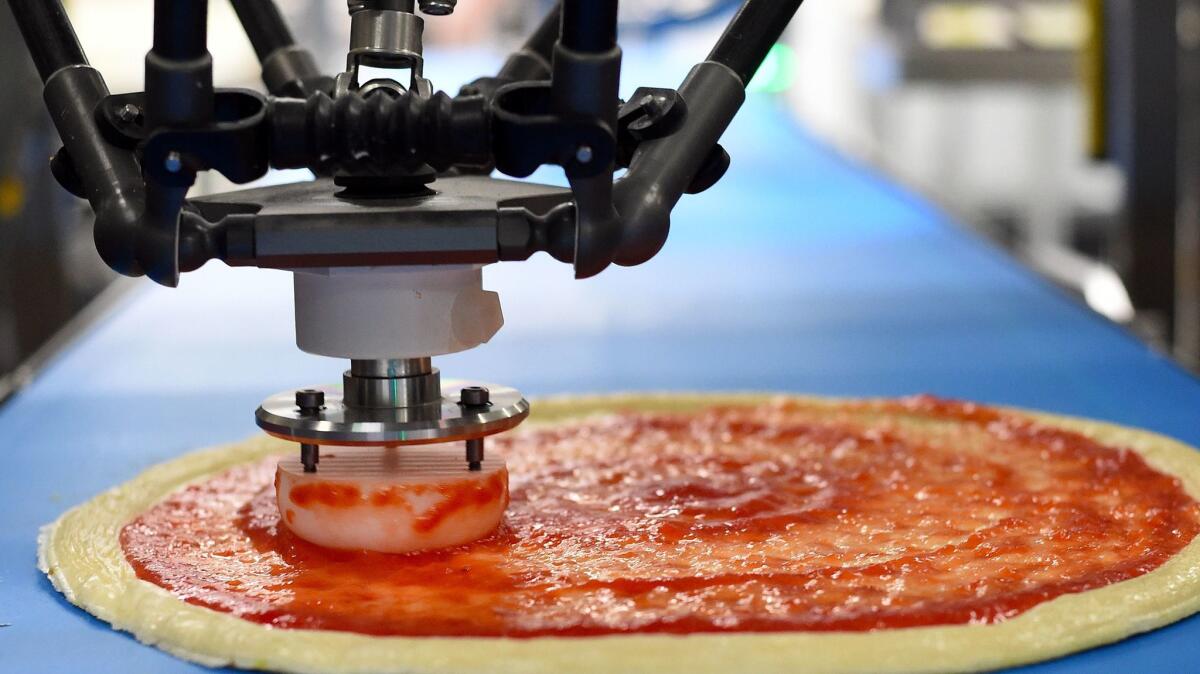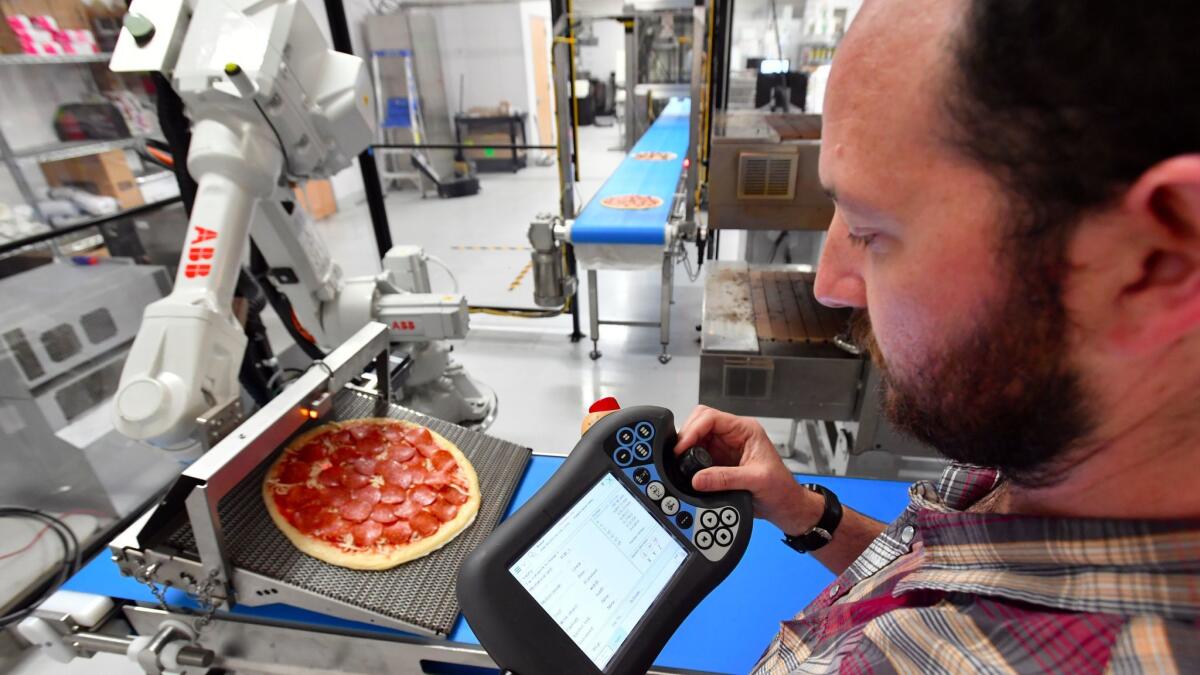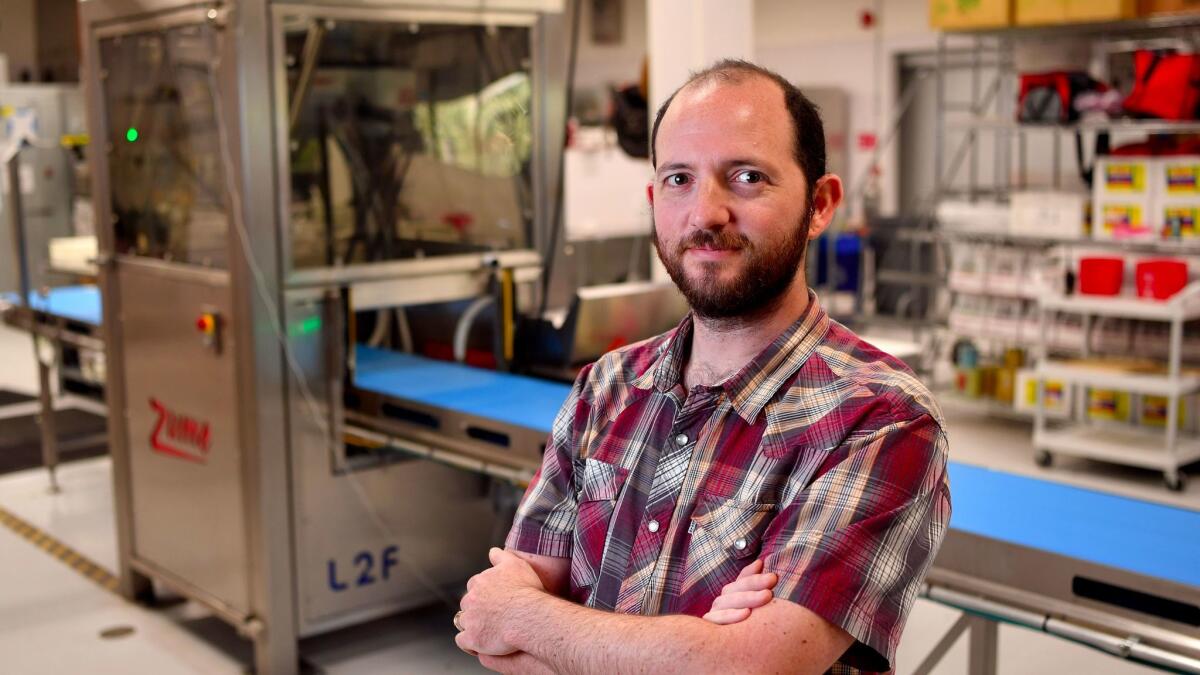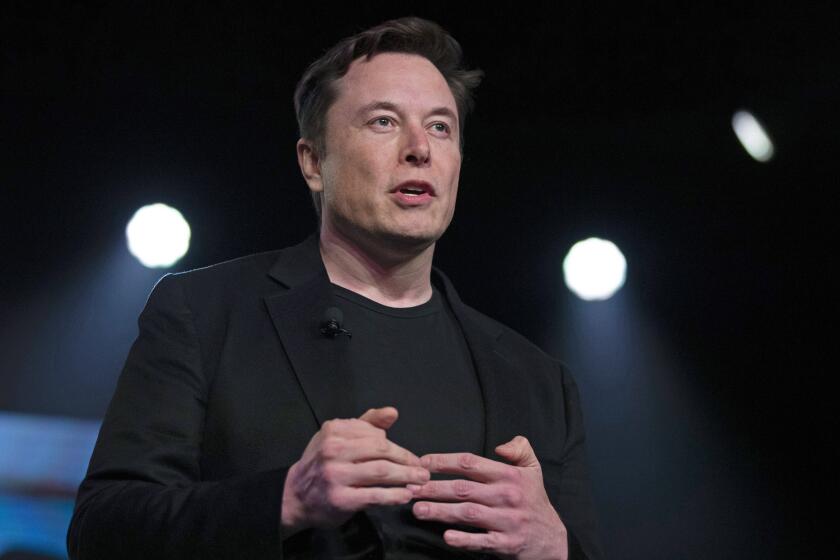Silicon Valley has a new vision for the pizzeria. It involves lots of robots

Up in the sky like a big pizza pie ... is that a robot? (July 6, 2017) (Sign up for our free video newsletter here http://bit.ly/2n6VKPR)
- Share via
Not long after the pizzeria Zume opened for business last year, its kitchen staff noticed a problem with some of its pizzas: they had holes in them.
It wasn’t the fault of the workers, who rolled out intact dough bases. There wasn’t a kitchen mole prodding holes. It wasn’t even the recipe — a Zume pizza base can handle its fair share of toppings. It was the robots.
Josh Goldberg, 38, is the chief technology officer of the Mountain View, Calif., pizza joint. Although most pizzerias don’t have an engineering staff, let alone a CTO, Zume prides itself on its use of automation to make operations more efficient.
It estimates its kitchen can make 10 times more pizzas than a pizzeria with a comparable staff. It has a robot that squirts tomato sauce onto its pies. It has a robot that spreads the sauce, mimicking the movements of Zume’s head chef. There’s a robot arm (similar to those found in auto manufacturing facilities) that puts the pie in the oven. And, as of this month, there’s a robot that presses the dough into a perfect circle.
So if the company has a non-human problem, it’s Goldberg’s problem.

Observing operations in the company’s lab-like kitchen, Goldberg watched as the human cooks spun glossy blobs of dough and placed them on the conveyor belt. He watched as a camera hovering above snapped a photo of the dough so it could inform the other robots of the pizza’s size, shape and precise location. Another camera detected the center of the pie and instructed a nozzle to squirt sauce, and a delta robot — the kind used on assembly lines — used a spiral movement to spread it. Humans topped the pizza with pepperoni, fresh basil and cheese.
And just as the pizza was about to be put into the oven, Goldberg found the problem.
There was a small gap between two conveyor belts. If both kept moving, then the pizza would glide along without any problems. But if the conveyor belts stopped for as little as two seconds, part of the pizza would sink into the gap, creating a tear when the machines started up again.
Fixing the problem was easy enough. Goldberg just had to program the conveyor belt to not stop when a pizza was passing over the gap.
But there are always new problems.
Robots need calibrating, code needs to be updated. Whenever there’s a change in the dough or sauce recipe, the robots must be taught new ways to work with different textures and consistencies.

That’s why Zume has a team of 20 software engineers. And its 20-person kitchen staff doesn’t just prep ingredients; many have been trained to work with the robots. Its entire culinary team uses project management tools such as Jira and Kanban, which are typically used by software engineers at tech companies for managing projects and fixing bugs. And other staff, such as delivery drivers and line cooks, are being trained in data science.
“We have fewer people, but we pay them much higher rates with full benefits as opposed to having a proliferation of lower-skilled workers,” said Julia Collins, Zume’s co-founder and co-chief executive.
The goal isn’t end-to-end automation, Collins said. There are still things that humans do better than machines, such as prepping ingredients, making sauce, developing recipes and knowing when something isn’t right with a pie. But automation and software enables Zume to reduce costs, make more pizzas, predict what pizzas people want before they order them and, eventually, take on the big pizza chains.
At least that’s what investors — including the venture capital firm SignalFire — are betting. They’ve put more than $23 million into the company.
Zume is a new player in the “better pizza” movement, in which upstart chains such as Blaze and 800 Degrees have built big followings by offering higher quality ingredients with the speed and convenience of Domino’s and Pizza Hut. And with its focus on robotics, Zume joins a small but growing wave of eateries — so far rooted in the Bay Area — that see automation as a way to reduce costs.
To expand its operations, the company says it won’t need to invest heavily in kitchens or storefronts. It will need only a single new robot-equipped kitchen in each new metropolitan market, relying on its fleet of oven-equipped trucks, each with the capacity to bake and deliver more than 200 pizzas a day — about the number of pies a single pizzeria sells.
“Ultimately, it’s a company that can scale and become the best option for delivered pizza against any of the incumbents,” said Chris Farmer, a SignalFire investor.
But if it succeeds, it has the potential to eliminate lots of repetitive jobs. The restaurant industry is projected to employ 14.7 million people in 2017 — about 1 in 10 working Americans — according to the National Restaurant Assn.
Joe Pawlak, managing principal at restaurant industry market research firm Technomic, says it’s more likely that robots will alter restaurant jobs than erase them.
“Automation will change the complexion of the workforce more than it drastically changes numbers,” he said.
That’s because many diners want food that’s hand-crafted and made with care — not put together an on assembly line, he said. Pawlak believes the restaurant industry workforce could grow more sophisticated as robots pick up some of the more repetitive jobs.
Collins, the Zume executive, sees an opportunity to train today’s low-skilled workers for tomorrow’s robot wrangling, and to create high-tech jobs where they previously didn’t exist — such as Goldberg’s role at the pizzeria.
“I’m the every-technology minder,” said Goldberg, who oversees Zume’s robots, conveyor belts, software, apps, and the ovens built into the trucks that let the company cook pizzas while they are being delivered.
Goldberg got his start in electrical engineering in the 1990s before making the switch to software development. He worked at an e-publishing company at one point, spent nearly a decade developing software and systems for online dating sites, and has run his own web-hosting business on the side. His last food service industry job was 23 years ago when he worked in a bagel shop.

“When I told people I was leaving my old job and going to make pizza, they thought I was joking,” he said.
But as automation becomes more pervasive, a growing number of his peers are finding work in industries that previously had no need for them.
One of the big pushes came decades ago when car manufacturing became automated, and software engineers found themselves building the machines that built the machines. As automation enters new industries — food, finance, healthcare — he believes engineers will find themselves in places they never imagined. In San Francisco, engineers already are working at automated coffee shops, quinoa restaurants and, soon, burger joints.
Previously confined to a desk, Goldberg’s engineering duties now have him going back and forth between Zume’s engineering office and the kitchen next door. He works with Zume’s chefs to figure out what technology they need to get the robots to follow the culinary team’s recipes.
To update the robots’ software, Goldberg must unlock a metal closet a few feet from the pizza conveyor belts. It’s filled with wiring that controls all of the robots — and can be accessed only in person to prevent a hacker from taking control of the pizza assembly line.
It’s one way the job differs from other engineering gigs.
“If it’s virtual and someone says, ‘Hey look, this thing is on fire,’ it just means the process has gone wrong,” Goldberg said. “Here, if something is on fire, they could be speaking literally.”
Times staff writer Alexa D’Angelo contributed to this report.
ALSO
Santa Monica couple fights Snapchat over ‘geofilter’ trademark
Private-sector job growth slows to still-solid 158,000, ADP says
Upfront Ventures, L.A. County’s biggest venture capital firm, just got bigger







